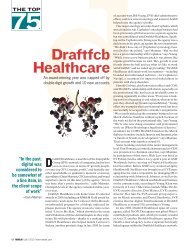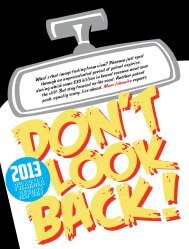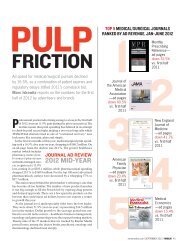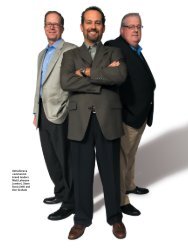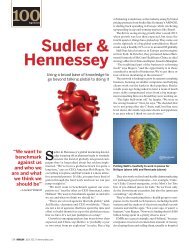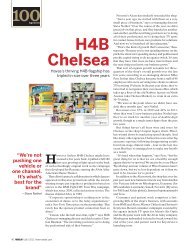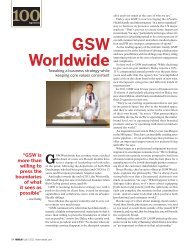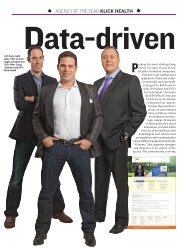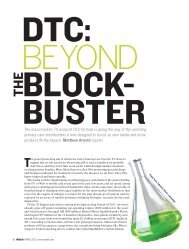LOOK - Medical Marketing and Media
LOOK - Medical Marketing and Media
LOOK - Medical Marketing and Media
You also want an ePaper? Increase the reach of your titles
YUMPU automatically turns print PDFs into web optimized ePapers that Google loves.
The sluggish economy, combined with what Michael Kleinrock,<br />
director, research development for the IMS Institute,<br />
calls “an unprecedented period of patent expiries,” led to a<br />
drop in overall drug spend of 1% last year to $325.8 billion—the<br />
first time IMS had ever recorded a decrease in US drug sales.<br />
The period from 2008-2012 was the biggest-ever for expiries,<br />
says Kleinrock. Following Lipitor’s 2011 patent implosion, last<br />
year saw the demise of mega-blockbusters like Bristol-Myers<br />
Squibb’s blood thinner Plavix. The impact is evident on the<br />
following list; only half the companies grew US sales.<br />
Kleinrock expects the same minus-one growth in 2013, due to<br />
“the carryover of 2012 expiries,” before spending rebounds in<br />
2014 <strong>and</strong> then another patent peak hits. The two peaks—2011-<br />
12 <strong>and</strong> 2014-15—are relatively similar in size, with about $30<br />
billion of lost sales per year for br<strong>and</strong>s.<br />
Milder impact from expiries, breakthrough drug approvals,<br />
<strong>and</strong> healthcare reform will drive spend on prescription drugs<br />
to rise by 3-4% in 2014, IMS predicts. Growth will then fall to<br />
just over 2% in 2015 <strong>and</strong> climb again in 2016 to almost 4%.<br />
Why not a return to double-digit growth? Many new<br />
drugs target smaller patient populations. Also, generic meds<br />
accounted for 84% of prescriptions dispensed in 2012 <strong>and</strong>,<br />
in another five years or so, will probably reach 87%.<br />
“We’re at sort of a saturation point,” Kleinrock says, where<br />
“newer br<strong>and</strong>s with better efficacy will be used, <strong>and</strong> that will<br />
slow down all of these gains that generics are making.”<br />
That, <strong>and</strong> specialty drug prices, spending for which<br />
boomed 18.4% last year, according to Express Scripts. “The<br />
specialty drugs are less price-sensitive, <strong>and</strong> we will continue<br />
to see the portion of specialty medications grow in the total<br />
drug bill,” says Jeffrey Russell, North American managing<br />
director for Accenture’s life sciences practice.<br />
Revenue losses notwithst<strong>and</strong>ing, pharmas have helped<br />
shore up profitability <strong>and</strong> shareholder value by slimming<br />
down, doing mega-mergers <strong>and</strong> in-licensing products.<br />
Going forward, what capabilities will help them?<br />
“New products are the key to survival, ” says fund<br />
manager Les Funtleyder, now with Poliwogg. Some on<br />
the list are spending 17-20% of revenues on R&D. Yet,<br />
while pipelines have been looking more attractive, R&D<br />
attrition rates have risen. And due to major pressures in<br />
the pricing <strong>and</strong> reimbursement area, “The industry can<br />
no longer continue to emphasize clinical efficacy <strong>and</strong><br />
safety requirements to determine which therapies to<br />
develop,” Russell says.<br />
Comm<strong>and</strong>ing higher prices, even for personalized<br />
medicines, will take total product value <strong>and</strong> real-world<br />
evidence. If not, pricing levels will not be sustainable.<br />
“We have to do a better job when we bring new products<br />
to market,” agrees Robert Bazemore, president,<br />
Janssen Biotech. “The burden’s going to fall much<br />
more on us to demonstrate the value these products<br />
really add.”<br />
Janssen biologics like Remicade helped parent<br />
Johnson & Johnson keep US losses in check <strong>and</strong> to<br />
grow global revenue. But with Remicade due to hit<br />
the patent wall in 2014, the company exemplifies the<br />
pressure the industry faces.<br />
“Many expected industry growth to decline much<br />
more than it actually has ended up doing,” concludes<br />
Kleinrock. “To keep it at only -1% is a pretty big<br />
success in a number of ways.”<br />
With additional reporting by Matthew Arnold,<br />
Deborah Weinstein <strong>and</strong> Kevin McCaffrey<br />
DON T<br />
AbbVie 44<br />
Actavis 45<br />
Amgen 43<br />
<strong>LOOK</strong><br />
AstraZeneca 41<br />
Boehringer Ingelheim 45<br />
Bristol-Myers Squibb 44<br />
Eli Lilly 43<br />
Gilead 46<br />
BACK<br />
GlaxoSmithKline 42<br />
Johnson & Johnson 44<br />
Merck 40<br />
Mylan 45<br />
Novartis 40<br />
Novo Nordisk 46<br />
Otsuka 46<br />
Pfizer 40<br />
Roche 42<br />
Sanofi 44<br />
Takeda 46<br />
Teva 41DON’T



